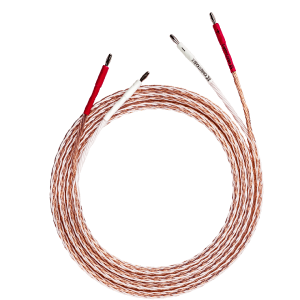By Kevin Gallucci
Most hi-fi and home cinema enthusiasts will eventually be faced with the dilemma of whether or not to purchase expensive speaker cables. Speaker cables are one of the most hotly debated topics in the hi-fi world. There are some who will adamantly state that cabling makes a difference, and there are those who say speaker cabling isn’t very important.
I’ll make it clear that I stand somewhere in the middle of the spectrum. Having worked in sales for a high-end wire and cable manufacturer who produced industrial-grade cables, I have a decent idea of what goes into making a quality insulated cable. I have also been reviewing audio equipment for a long time, including some speaker cables.
 I’ll be the first to admit that speaker cables can be quite the enigma. I’ve heard very expensive speaker cables which sound great, and I’ve also heard really affordable cables with surprising sound quality. So what gives? In the modern world we live in, we often are brainwashed into believing that the more expensive something is, the better it has to be. This isn’t always the case, and in my opinion, isn’t the case for speaker cables. With more expensive speaker cables, you might get more exotic materials, but this doesn’t always equate to better sound. My personal opinion is that there are several factors that are important in speaker cables. Here is a list what I’ve learned to look for in a good speaker cable.
I’ll be the first to admit that speaker cables can be quite the enigma. I’ve heard very expensive speaker cables which sound great, and I’ve also heard really affordable cables with surprising sound quality. So what gives? In the modern world we live in, we often are brainwashed into believing that the more expensive something is, the better it has to be. This isn’t always the case, and in my opinion, isn’t the case for speaker cables. With more expensive speaker cables, you might get more exotic materials, but this doesn’t always equate to better sound. My personal opinion is that there are several factors that are important in speaker cables. Here is a list what I’ve learned to look for in a good speaker cable.
 Quality Conductors
Quality Conductors
- Copper and silver are the two most common conductors used in speaker cables. Make sure the cable manufacturer is using high-purity conductors. A quality speaker cable manufacturer should be able to tell you what purity level the conductors are that they’re using to build the cable.
Twisted Construction to Help Reduce RFI
- Quality cable manufacturers will typically braid conductors together to ensure the conductors aren’t running parallel next to one another. By running parallel, they could be acting like an antenna, thus making them more susceptible to picking up radio-frequency interference (RFI) from cellphones, Wi-Fi or traditional radio signals.
Well Engineered Connectors
- A well engineered cable can be hampered by a poor quality connector. Make sure the speaker cable you’re interested in has a well engineered design and is made of conductive materials such as copper and silver.
Quality Insulation
- Teflon is considered by most to be the best insulation for wire conductors. It is believed to have the least impact on the conductors. However, there are other insulation materials out there that work well, so do your homework before choosing a cable purely because it has Teflon insulation.
Try before you buy – The Cable Company offers a service called the “Lending Library.” They will let you demo cables from over 60 manufacturers for 5% of the purchase price. If you’re hesitant to make the jump into purchasing quality speaker cables, this might be your best option to see how certain brands will sound in your own system.
www.thecableco.com/lending-library
Below are few quality speaker cables to try out
AudioQuest Type 4 – $209.00 per 6’ pair www.AudioQuest.com
Kimber Kable 8TC – $401.00 per 6’ pair www.Kimber.com
Cardas Audio Iridium – $260.00 per 2m pair www.Cardas.com
The post Speaker Cable: How Much Should You Spend? appeared first on Electronic House.
source https://www.electronichouse.com/home-audio/speaker-cable-how-much-should-you-spend/
No comments:
Post a Comment